Editor’s Note: This article is the third in a three-part series addressing landmines and other unexploded ordnance in Cambodia, a remnant of past conflicts continuing to impact the safety and livelihoods of people living near former war zones.
The incendiary insides of a Russian recoilless rifle round may be intimidating to most, but Joe Valdez tinkered without hesitation.
Documenting the dismantling of the bits and bobs to remove explosive hazards was strictly off limits, though.
“I don’t want anyone to see a photo or video of what we’re doing and then try to do it at home,” explained Valdez, a master-level explosive ordnance disposal technician and the Explosive Harvesting Program manager for Golden West, a humanitarian demining group operating in Cambodia.
Unsurprisingly, recycling the combustible contents of decades-old bombs, also known as explosive harvesting, can be an extreme health hazard. Though for Valdez and his team, it is just another Friday.
In a region riddled with remnants of war, a harvesting programme with the sole purpose of supporting ‘mine action,’ the removal of landmines and other unexploded ordnance, is unique to the Kingdom.
Golden West has harvested nearly 33,000 ordnance items since 2005 and by March had recycled these remnants of war into more than 584,000 explosive charges used to destroy unexploded ordnance.
The process converts the explosive materials from these remnants into small charges, which are used to destroy ordnance unsafe to move. The programme saves humanitarian demining groups the expense of commercial-grade explosives. Amidst the fickleness of funding in the wake of modern conflicts, finding affordable mine action methods is likely to become only more significant.
These changes coincide with a global push for environmentally responsible mine action that relies less on blowing up war remnants, which spreads steel shrapnel, explosive residue and hazardous chemicals while blasting craters into the land.
While this is a tall order when dealing with hundreds of kilograms of buried explosives on a limited budget, experts said it can be met partly through explosive harvesting – turning dangerous old weapons to a more peaceful task.
Golden West’s explosive harvesting facility in Kampong Chhnang province, two hours northwest of Phnom Penh, is a melting pot – literally and figuratively – for Cambodia’s unexploded remnants of war. This broad term describes ordnance items, from landmines and grenades to artillery rounds and aerial bombs, left behind after three decades of conflict in the past century.
If an ordnance item is deemed safe to move and the explosive materials within declared usable, the recycling process begins.
Each weapon is slowly sliced open by a band saw equipped with cutting fluids designed to reduce heat. This separates the fuse from the explosive materials and provides access to the inner workings of the weapon. The combustible section is then steamed, eventually causing the explosive material to ooze out of the ordnance. Finally, the contents are melted and mixed with other explosive fillers, forming a cocktail that is recast into a small explosive charge.
The 100-gram (3.5 ounce) charges, or electric blasting caps, are given to the Cambodian Mine Action Centre to be distributed among demining crews, who use the charges to destroy ordnance items unsafe to move.
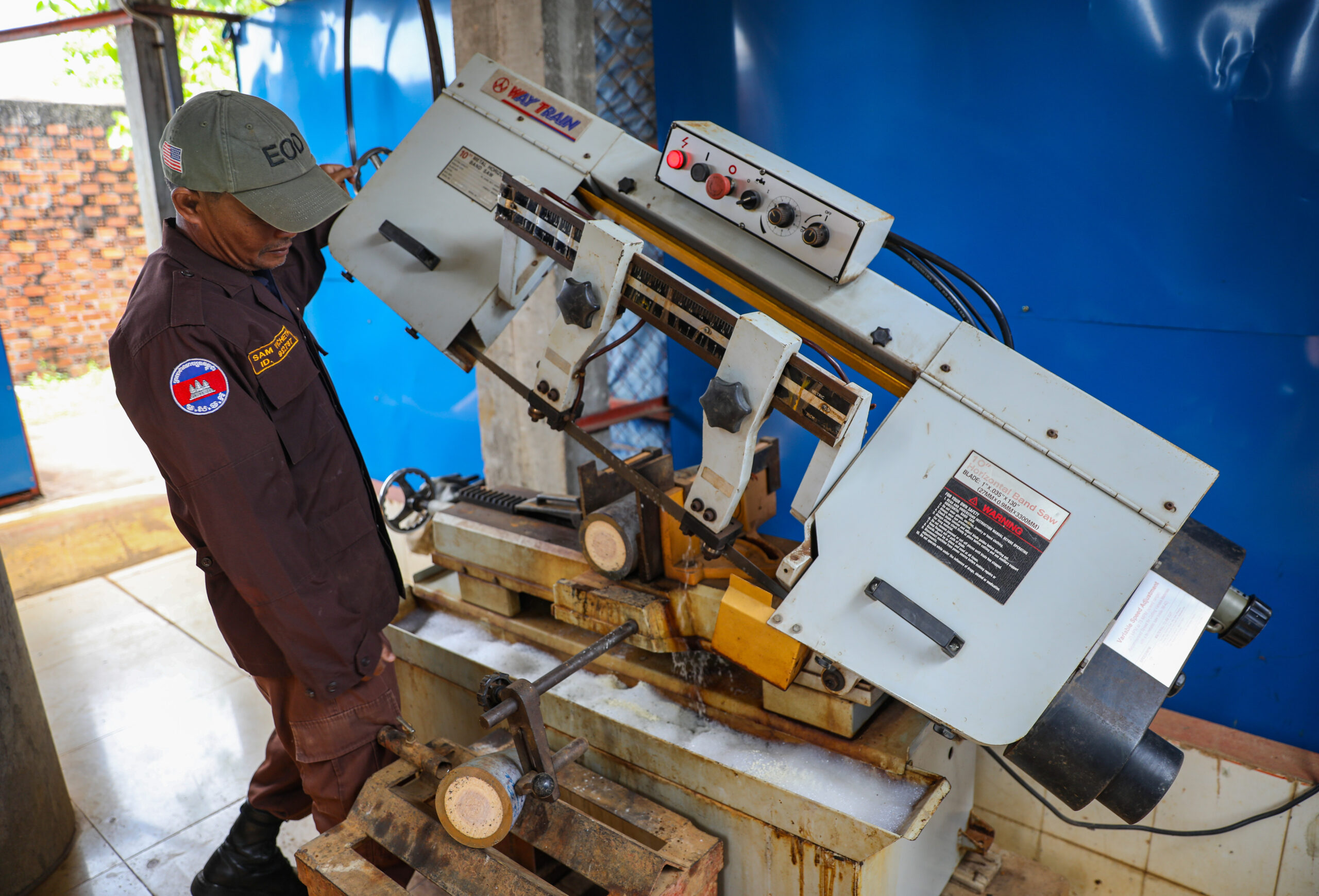
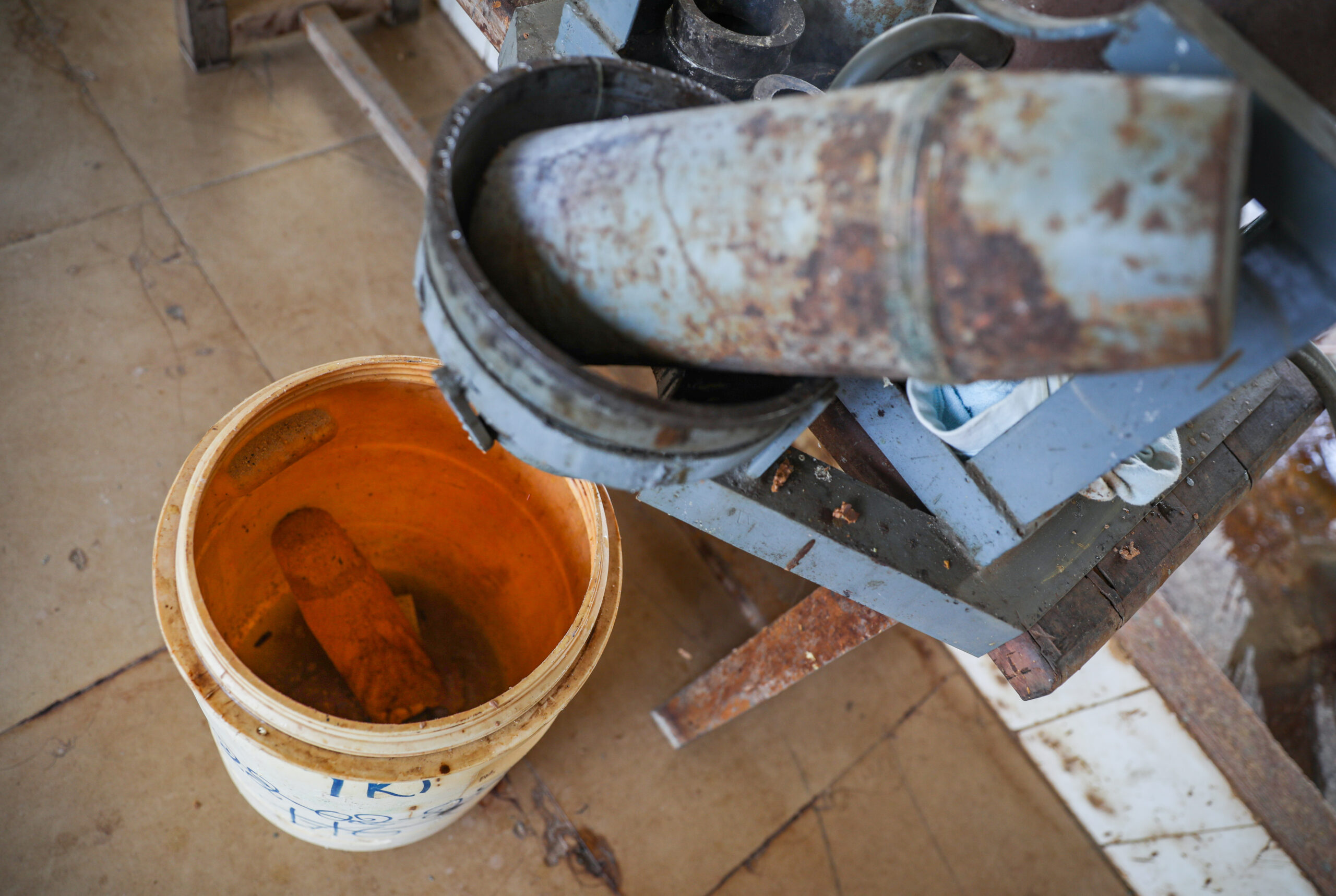
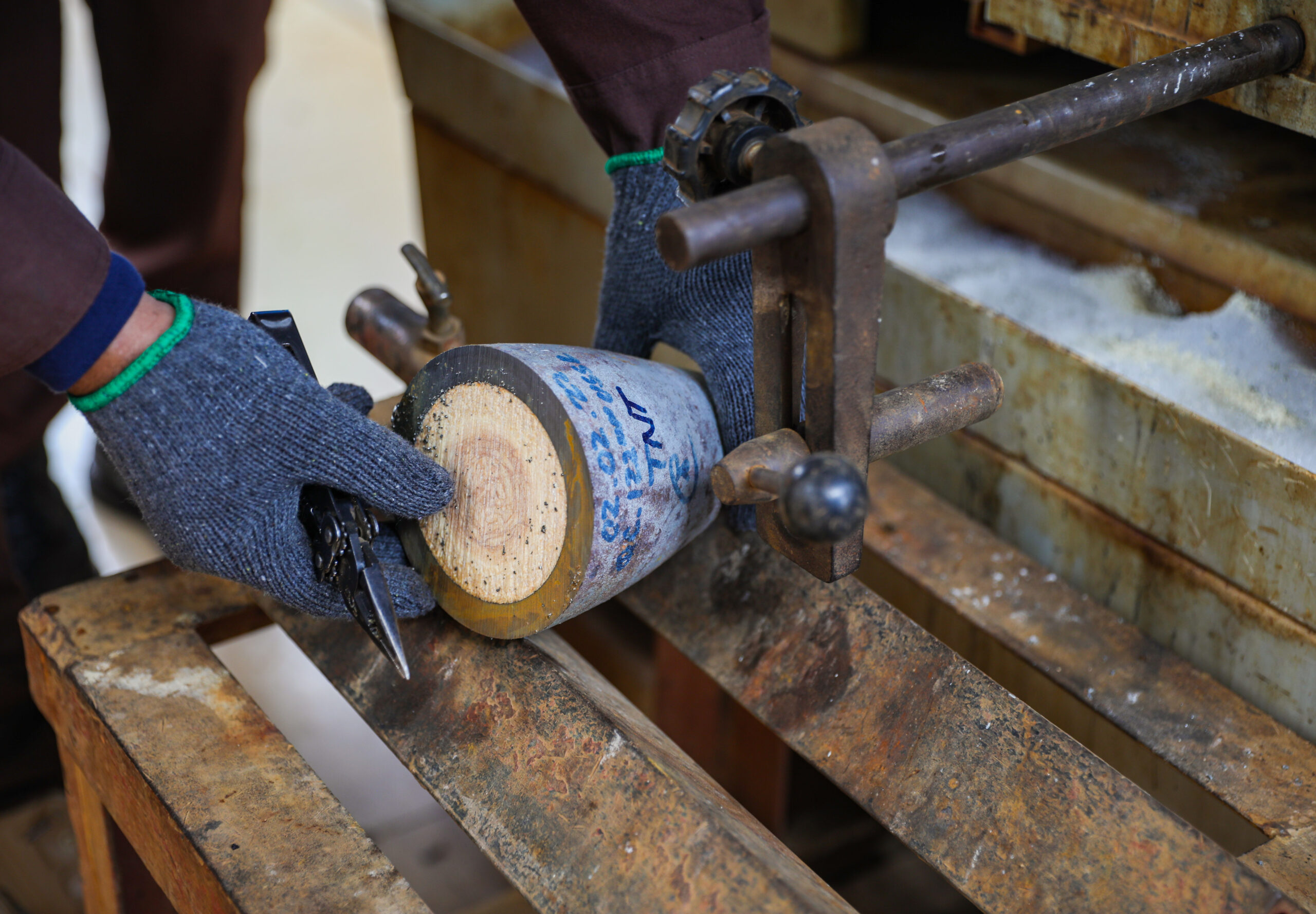
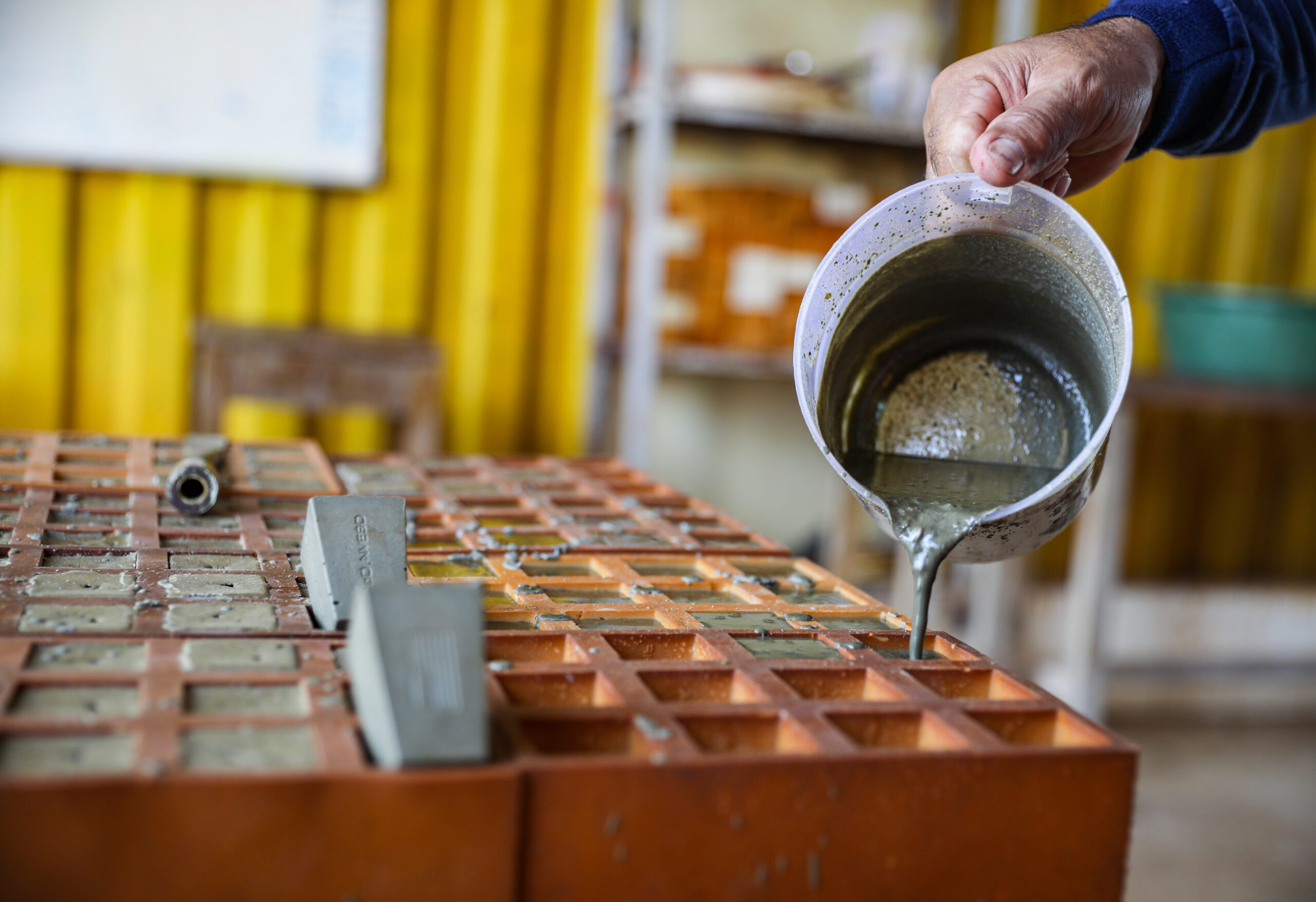
Explosive harvesting begins with an ordnance item sliced open by a band saw equipped with cutting fluids designed to reduce heat. The combustible section is steamed, causing the explosive material to ooze out of the ordnance. This is mixed and melted with other explosive materials and recast into small explosive charges.
The process gets the most “bang for one’s buck” when recycling U.S.-made aerial bombs, which often contain a greater amount of reliable explosive material, Valdez said. Cambodia’s National Mine Action Strategy published data from the U.S. State Department that recorded 2.75 million tons (2.49 million metric tonnes) of bombs dropped on the Kingdom during the Vietnam War from 1965 to 1973.
“To be very honest, as a bomb disposal guy, it didn’t appeal to me immediately because it involved doing things to munitions that we really normally don’t do,” Golden West CEO Allan Vosburgh said, referring to three key words “everyone in the bomb disposal business tends to avoid: heat, shock and friction.”
The explosive harvesting process requires friction and heat. But it is made safe, Valdez explained, because heat and friction are caused separately and at low levels.
“Obviously, we wouldn’t do this if it didn’t work safely because if it didn’t, it would be pretty obvious,” Valdez said, expanding his interlocked fingers to mime an explosion. “Over the years, we have identified explosives that are easier to manipulate, and safe to melt and repurpose.”
On request, Valdez also recycles the ordnance item itself, like he was doing with the Russian recoilless rifle round. After harvesting, he reassembles the inert weapon and removes part of the exterior so it can be used as a teaching aid during explosive ordnance disposal classes.
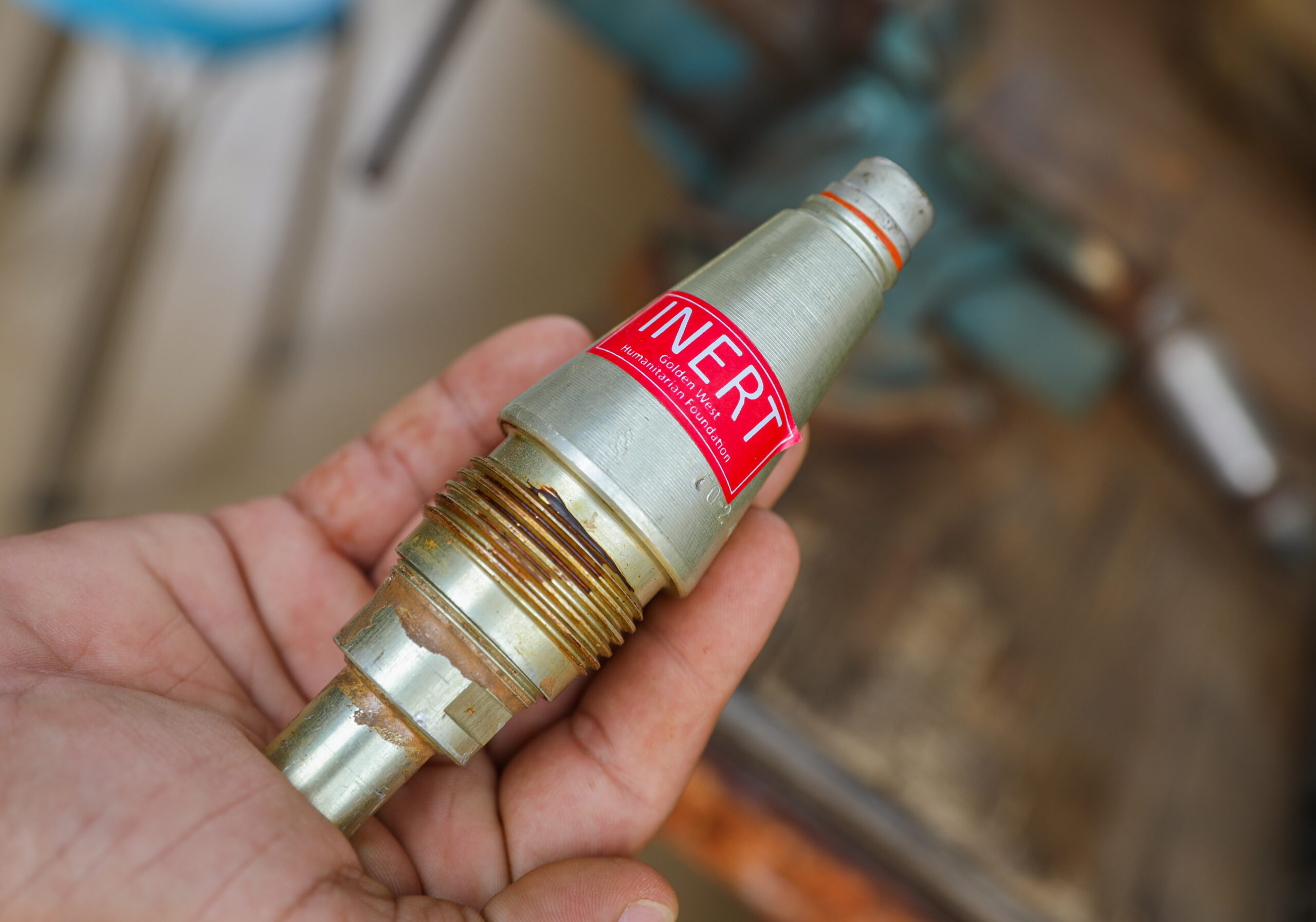
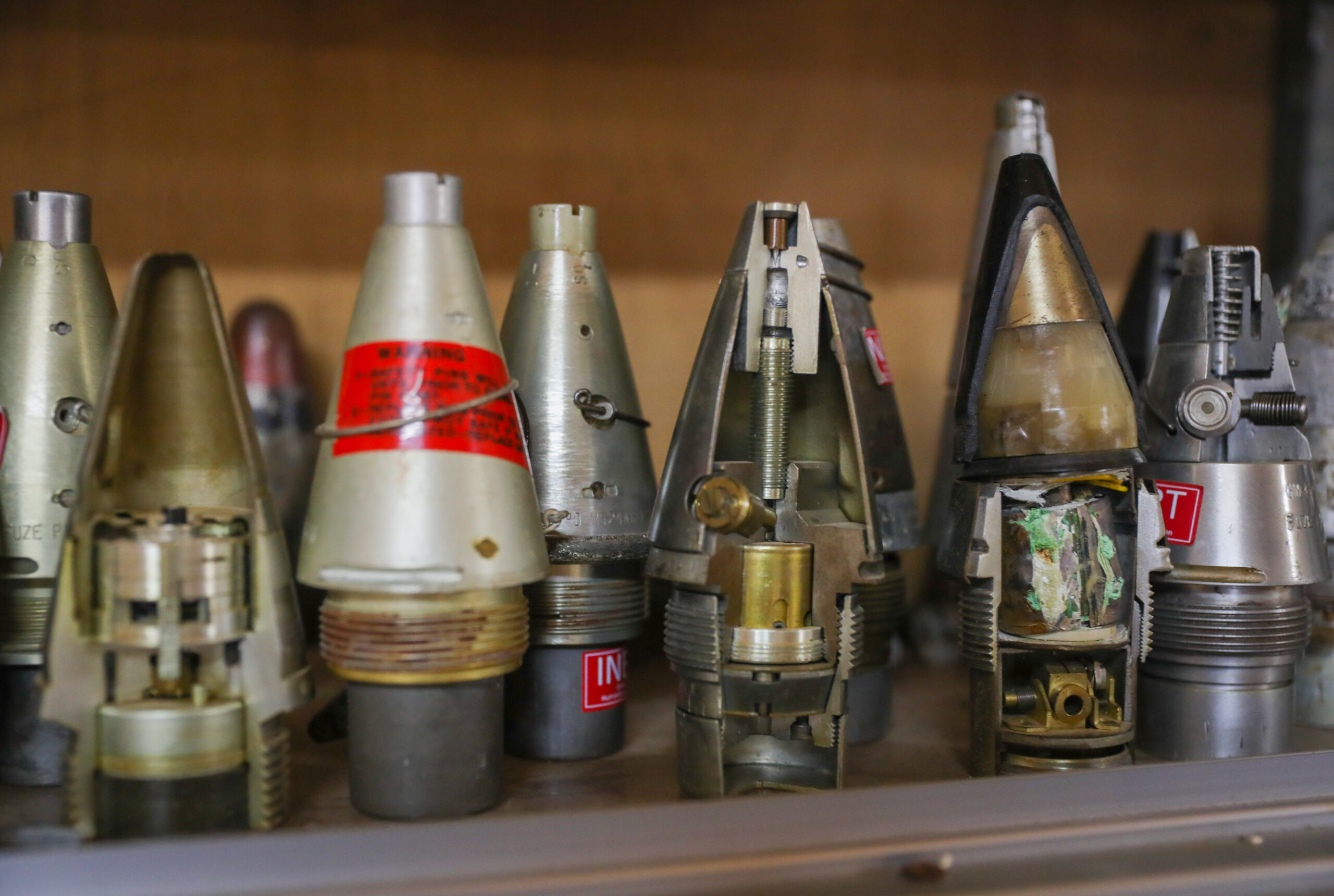
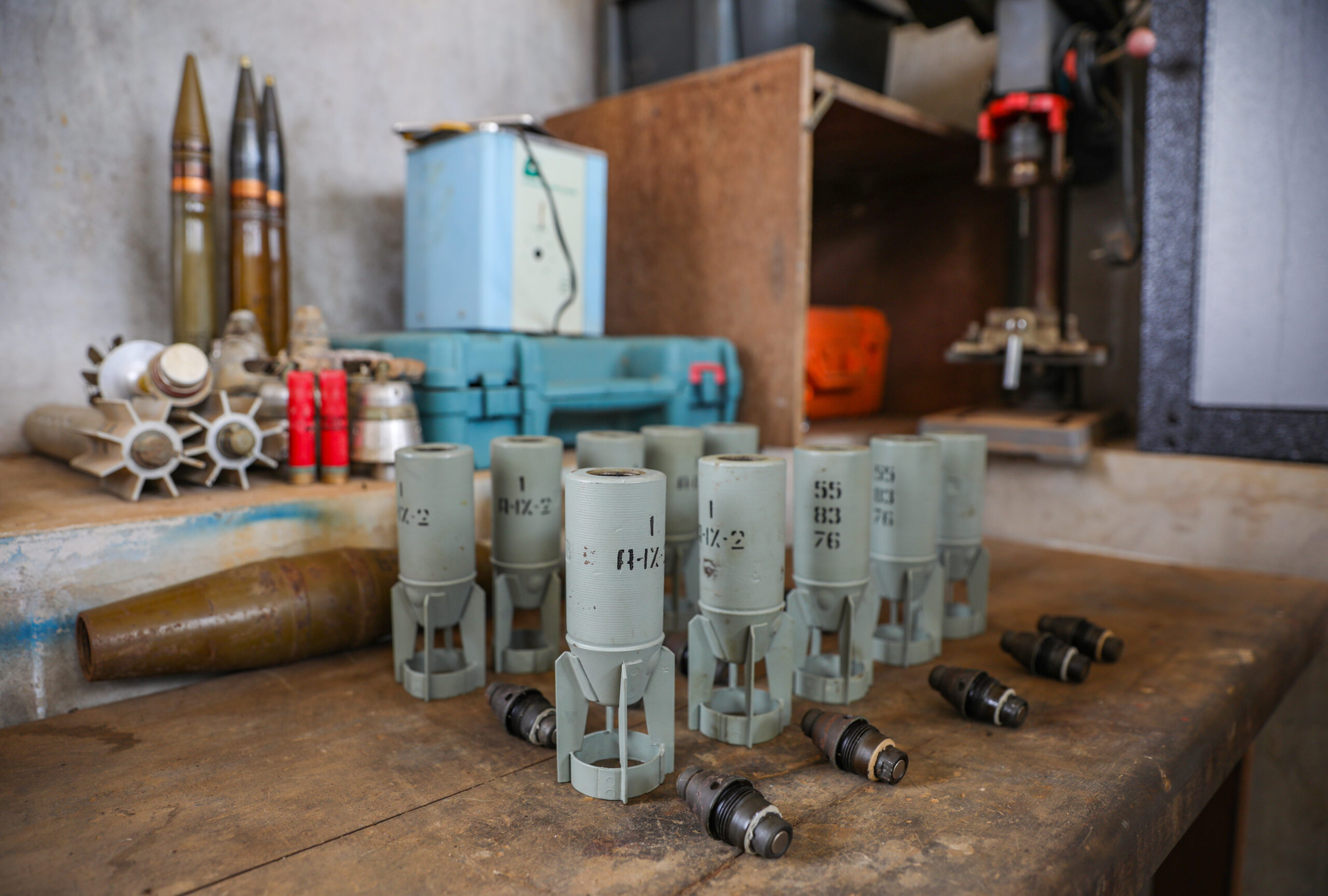
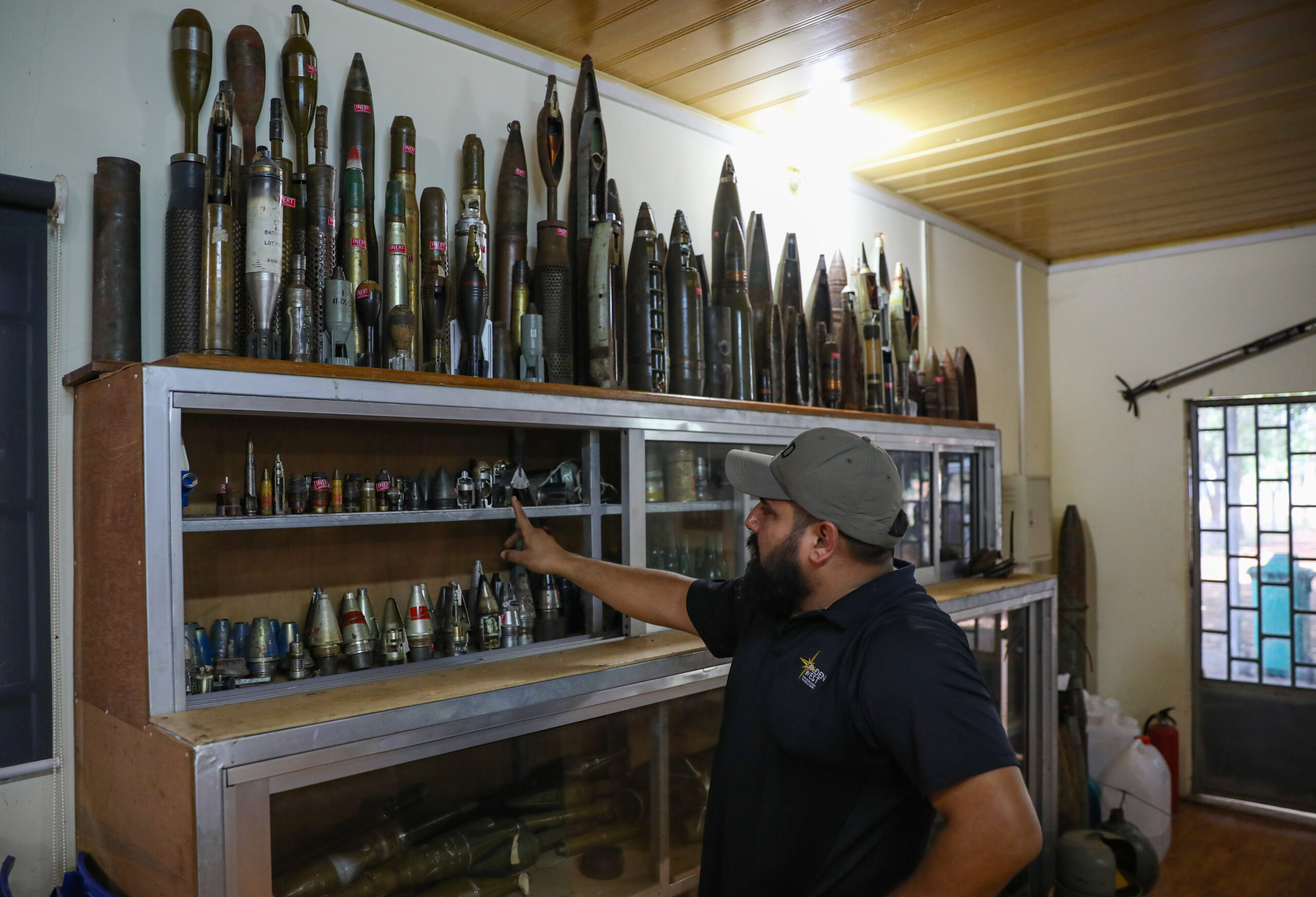
Joe Valdez, a master-level explosive ordnance disposal technician, recycles ordnance by disassembling the weapons to remove explosive hazards. Valdez reassembles the inert war remnant and removes part of the exterior to be used as a teaching aid for explosive ordnance disposal classes.
Harvesting explosives cuts costs for commercial-grade explosives, and saving funds is particularly relevant to modern mine action.
“In the demining business, the biggest cost is often personnel costs. But actually, in places like Cambodia, where you can hire people at a reasonable cost, it is not that bad. Making explosives the biggest cost for demining programs in Cambodia,” Vosburgh said.
Mine action is often funded by donors. The end of wars and the beginning of new ones, however, has led to budget uncertainty among humanitarian demining groups, emphasising the need for more affordable techniques, Vosburgh explained.
“Not every country has the ability to purchase or is financially stable enough to buy explosives at the commercial level,” Valdez said, adding that explosive harvesting “is a minimal cost effect to the country and it is something we can pull from ordnance items within their own borders.”
The search for funding is a constant feature for such programs, and the subject of money drew a sigh from Andrew Grantham when it came up in conversation.
A member of the Geneva International Centre for Humanitarian Demining’s ammunition management advisory team, Grantham explained that “whether you are commercial, humanitarian, or whatever, we all need money to function.”
“Donor states have their priority areas. They have their places they have always assisted. Being realistic, the focus of states does move. We saw it in Iraq. We saw it in Afghanistan. Ukraine is going to require a massive cleanup when hostilities finish,” Grantham said. “Being realistic, funding does move around.”
As long as programmes “show they are being as cost effective as possible and that the donors are getting value for money,” he hopes donations will continue in countries like Cambodia still dealing with the remnants of wars long past.
Explosive harvesting is particularly useful in Cambodia because of what Grantham called the country’s “high level of contamination.” While a similar programme may not be as replicable in countries with less unexploded ordnance, he believes Cambodia has found a solution that “closes the circuit.”
Historic conflicts across the region, from the Khmer Rouge takeover, genocide and deposal, to the Vietnam War and World War II, perforated Southeast Asia with ordnance. But while explosive harvesting likely occurs elsewhere in Indochina, the use of a recycling programme for humanitarian demining exists only in Cambodia.
Golden West did not invent the process, Vosburgh noted, but the group “re-scaled” explosive harvesting for the demining community.
The Cambodian Mine Action and Victim Assistance Authority signed an agreement in April with Golden West to promote skills and technology modernisation in mine sweeping jobs to enhance miner security and contribute to the “liberation of the land for the citizens.”
Harvesting in Cambodia and Golden West’s unexploded ordnance disposal trainings across Indochina are additionally fuelled by a personal passion and promise for Vosburgh, whose three decades in the U.S. military included a Vietnam War deployment. He served as an aviation munitions ordnance technician, personally fixing aircraft weapons and bomb release systems.
“I served in Vietnam and I was involved in every fight we’ve had since. One of my long-term goals was to try to go back to Vietnam, and Southeast Asia, to mitigate the problems created by unexploded ordnance,” Vosburgh said. “I can’t throw rocks at what 21-year-old me did, I did what I needed to do. But in hindsight, we could have done it way differently and I am trying to do my little bit to correct those problems.”
While harvesting techniques such as cutting open ordnance to melt its contents also have been used to dispose of war remnants in Vietnam and Thailand, “Cambodia is the only place that has a full-on explosive harvesting programme the way we envisioned it,” he said.
“We are always looking for ways to make that faster, safer and more cost-effective and environmentally friendly,” Vosburgh said.
If a remnant of war is too dangerous to move, deminers fight fire with fire.
“Explosives will always be needed in mine action,” said Valdez, referring to the industry practice of blowing up unsafe unexploded ordnance.
There is, however, a global shift towards decreasing the use of high-order detonations and burning explosive materials. More emphasis is being placed on developing and investing in environmentally responsible disposal methods.
“Worldwide we’re seeing a big move to start limiting groups going around blowing stuff up, it does a lot of environmental damage,” Vosburgh said, elaborating that detonations can spread steel shrapnel, explosive residue, hazardous chemicals and create large land holes.
“There are always going to be munitions that you can’t possibly move safely. In a case like that you only have one recourse,” Vosburgh conceded, listing examples like booby-trapped anti-personnel landmines. “But if you can possibly limit that recourse, it will reduce damage to air, water and soil.”
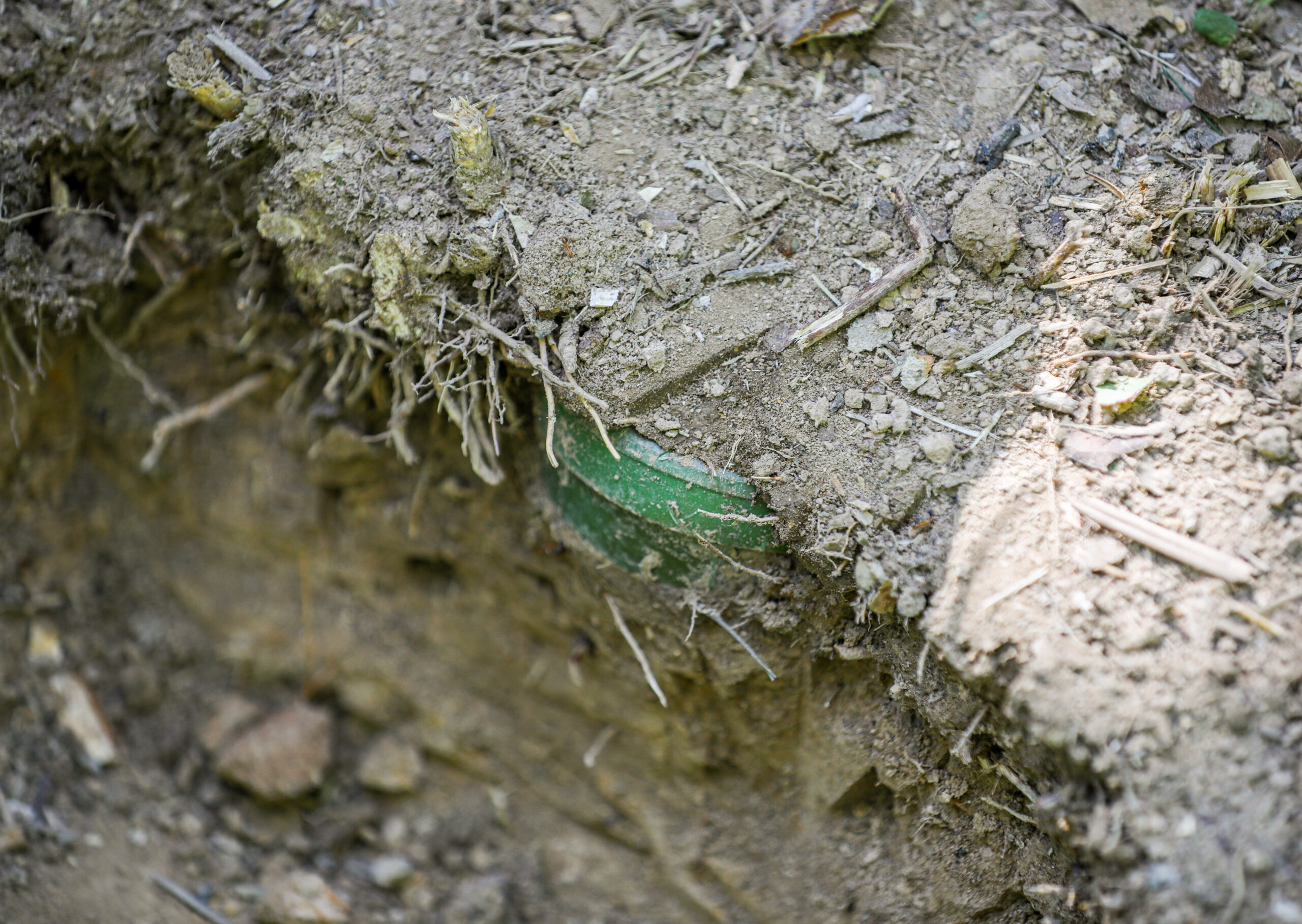
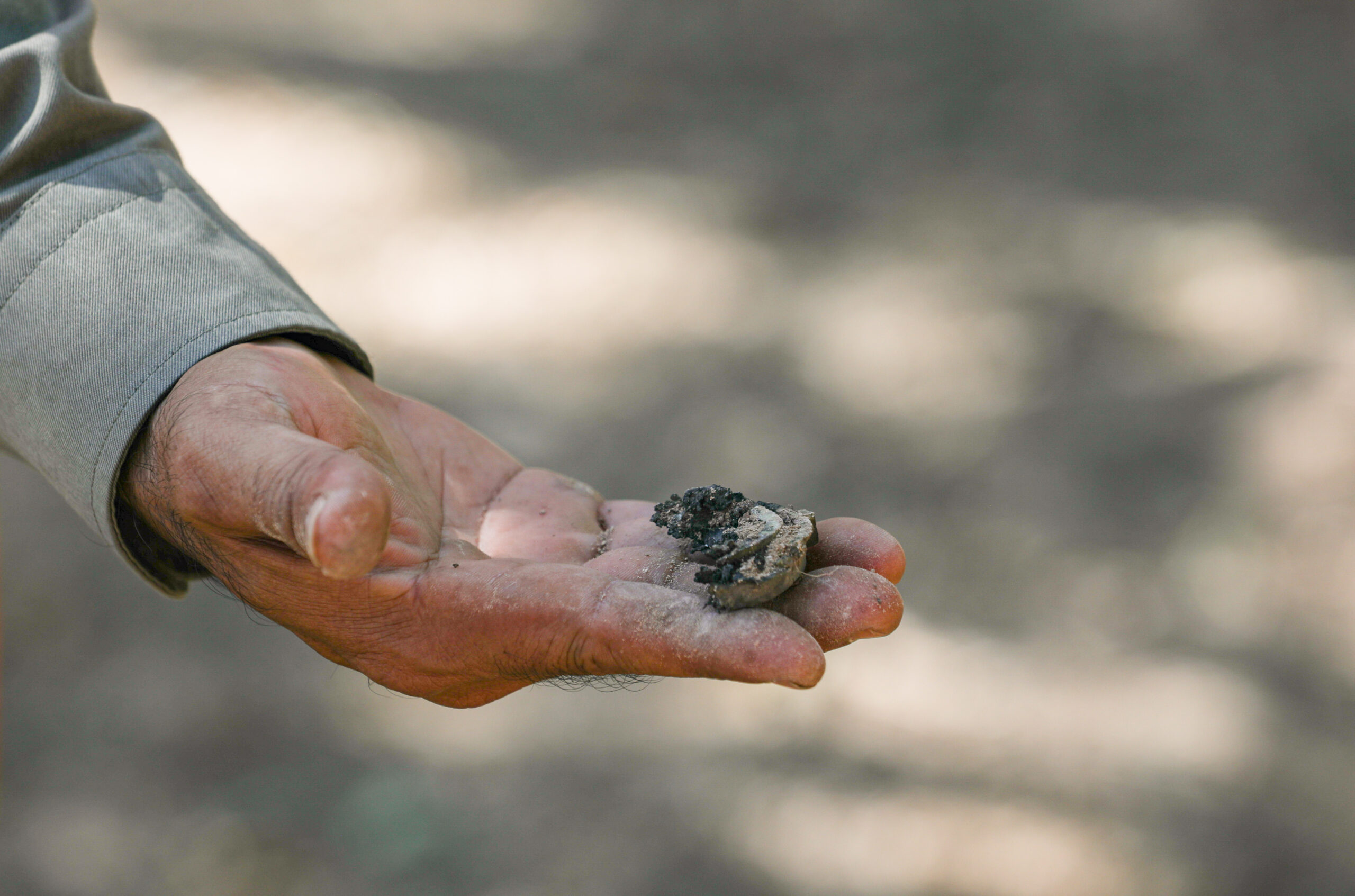
A Type 72b anti-personnel landmine before, left, and after, right, an explosive charge is used by members of Cambodian Self Help Demining to destroy the unexploded remnant of war. The mine was detected in Tuol Kruos village in Siem Reap province.
Linsey Cottrell, an environmental policy officer with The Conflict and Environment Observatory in the U.K., believes explosive harvesting is “one of the tools in the bag in respect to looking at alternatives to open burning and open detonation.”
“Safety is key. But if there is significant environmental contamination from a disposal technique, then that is a safety element as well, because it can impact the health of people,” Cottrell said. “It might not be immediate, but it may be a health impact down the line. Environmental is part of safety considerations.”
A commitment would be needed on all three levels of mine action – donor, deminer and regulator – for the environment to gain a prominent role in future efforts. Alternatives will be perceived as a higher cost, but future expenditures for cleaning up contaminated land and water could be just as hefty. “We need to consider the whole life cost of that process,” she said.
“A process never fully has no environmental impacts, and there is a need to make sure the whole process is managed appropriately so you haven’t got other unintended consequences,” Cottrell said. “If alternatives can be put in place to open burning and detonation, there is the opportunity to make mine action more environmentally responsible.”
The weekend could only begin after Valdez finished recycling the Russian recoilless rifle round, which ended when he dismantled the fuse and removed the explosive hazards.
Now inert, he set down the war remnant and waved towards the other three he planned to tinker with on Monday.
“Reduce, reuse and recycle, right?” said Valdez, who was asked by the Royal Cambodian Armed Forces to turn the weapons into teaching aids. “Most of the things we reuse and recycle for class, but not all.”
He nodded at a jerry-rigged aerial bomb, which was outfitted with four legs, topped with a grill and filled with crumbling charcoal.
“We call that,” Valdez began with a deadpan expression, “a bomb-eque.” He gave a cheeky chuckle, finding some levity in his crew turning “a weapon of war into a safe reason to gather family and friends.”
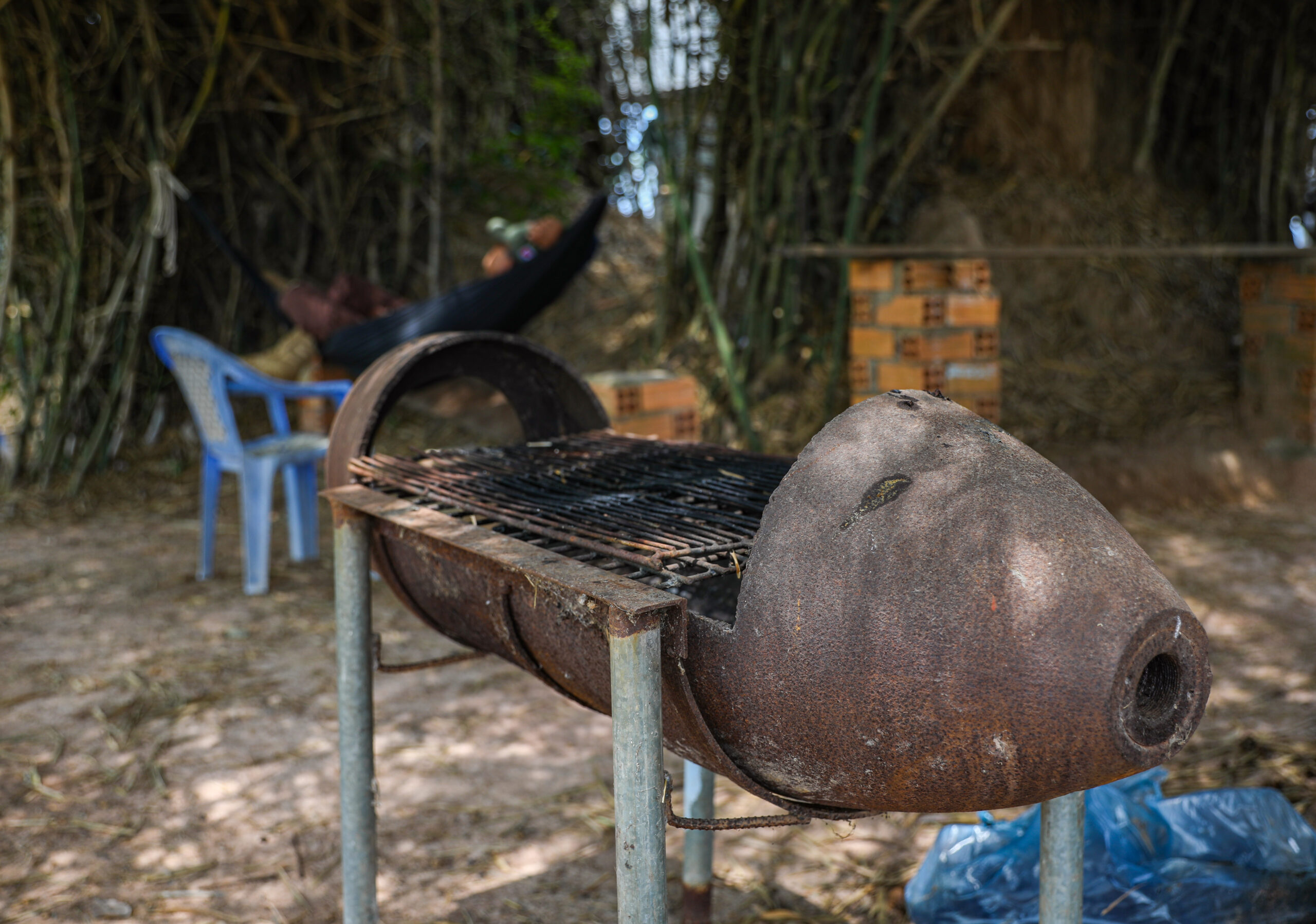
The first part of the three-part series on landmines and unexploded ordnances can be found here and the second can be explored here.


